Practical Sailor last took a look at Automatic Identification System (AIS) units with the November 2008 evaluation of the Raymarine AIS250, a receive-only device. Since that report, the pool of AIS products has grown to include several affordable transceiver options for recreational sailors-thanks in part to the U.S. Federal Communications Commissions giving the go-ahead last fall for AIS-Class B devices (those geared toward non-commercial boaters) to be sold and used in the U.S.
For this head-to-head test, we reviewed two Class B devices capable of sending and receiving AIS data: the Navico NAIS-300 and the West Marine AIS1000.
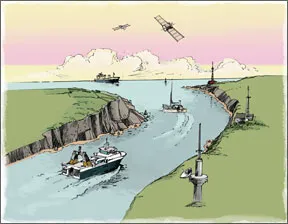
Illustration by Regina Gallant; photos by Al Herum
AIS 101
AIS transceivers help skippers navigate high-traffic areas safely by “talking” to other AIS devices. They use GPS to acquire position data and VHF channels to receive and broadcast a wide variety of information about a ship, including its name, latitude and longitude, course over ground, speed over ground, heading, status, and Maritime Mobile Service Identity (MMSI) number. AIS transceivers and receivers within VHF range “hear” this broadcast and use it to graphically show the boat and to report its static and dynamic information on a mated display screen.
In addition to showing an overview of marine traffic in the area, AIS transceivers also are useful for search and rescue. Like an activated EPIRB, they offer the Coast Guard and other rescue personnel the boats exact location.
AIS transceivers are split into Class A (commercial) and Class B (recreational), and they broadcast information from every 2 to 30 seconds. AIS listen-only devices, like the Raymarine AIS250 and SI-TEX/Nasa Marine receiver we tested (March 2007), receive AIS broadcasts but do not transmit any information.
In 2002, the International Maritime Organization (IMO)s International Convention for the Safety of Life at Sea (SOLAS) regulations made it mandatory that all ships over 300 gross tons carry and operate at all times an AIS-Class A transceiver.
Class A transceivers have a maximum VHF power output of 12.5 watts, are required to broadcast more data than Class B units, and must update data more frequently than Class B. IMO-compliant Class A devices, which start at about $3,500, are marketed toward commercial ships. Not only are they fairly cost-prohibitive for average sailors, but they also are beyond the scope of what most recreational boaters need.
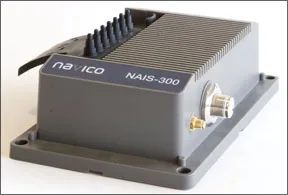
Class B transceivers are designed to provide a similar yet limited service, at a lower cost, to smaller vessels, which are not required to carry a Class A unit. Class B units transmit less data at a slower rate using a 2-watt transmitter. (See the table on page 24 for specifics on what data each class is required to broadcast.) Most Class B units on the market these days cost between $500 and $2,000, depending on capabilities and the number of accessories included.
Before an AIS-B transceiver can be used, some information about the boat and its owner must be input. FCC regulations specify which data must be input and require that it be done by the units dealer or authorized installer. The required information includes the MMSI number associated with the host boat; the boats name (up to 20 characters); a radio call sign; the boats length and beam (in meters); and the boat type. Having improperly entered data can land a boatowner a hefty fine of up to $25,000.
Not only does the IMO standards regulate what information is broadcast and when, but they also mandate how that information is displayed. Boats within VHF range that have an AIS transceiver turned on will appear as “targets.” A targets color will depend on its proximity to the boat doing the monitoring. For instance, “sleeping” targets, or those deemed not a collision threat, will always appear as blue, triangular icons no matter the display or transceiver being used. Ships with whom collision is possible appear as flashing triangles with red outlines.
Whether targets are considered collision threats or not depends on their location in relation to the users set safety zone. The process of setting the safety zone varies from display to display. Also dependent on the display used is the type of alarm that sounds when a target breaches the safety zone.
On the multifunction display (MFD) we used for testing, a Raymarine A50D, the safety zone around the host boat can be set based on distance-in one of four steps from one-tenth of a mile up to 2 miles-or time of closest approach, in one of four settings from three to 24 minutes. Should another vessel enter this safety zone, an audible alarm will sound and a warning will flash on the screen. Placing the cursor over a target shows the target ships heading, speed, closest-point-of-approach (CPA), and time/closest-point-of-approach (TCPA). This data can also be set to be displayed at all times. A heading vector for each target can be displayed, too.
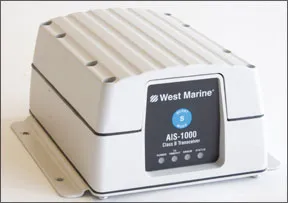
Numerous targets can be monitored and their information displayed simultaneously. To reduce screen clutter, some displays offer the option to not show Class B units. This handicaps Class B and AIS in general, and is a good reason to not put all your eggs in the AIS basket, in our opinion. As more and more recreational boaters adopt the Class B devices, this screen clutter-and the motivation to de-clutter or ignore it-will increase.
While AIS is a boon to collision avoidance technology, it comes with many “ifs.” The full usefulness of AIS-B can be realized only if ships in collision range are AIS-transceiver equipped; if their devices are turned on; if their ships data has been entered correctly; and if their screens are not set to de-clutter, or to ignore Class B broadcasts. But these devices can prove very useful when used in conjunction with vigilant watchkeeping, radar, VHF security calls, and good seamanship. They are especially effective in low-visibility conditions and high-traffic areas.
What We Tested
For this review, Practical Sailortested the Navico NAIS-300 and the West Marine AIS1000 Class B transceivers. Neither comes with a display, but both black-box units can be used with compatible chartplotters, multi-function displays (MFDs), or PCs. Per AIS standards, both require high-speed connections with data transfer speeds of 38,400 baud to accommodate all of the potential received ships transmissions. The units will not work with the slower 4,800-baud NMEA-0183 regular connections. Data transfers to PCs are via RS-232 connectors. To use a computer that lacks a built-in serial port, a serial-to-USB adapter is required.
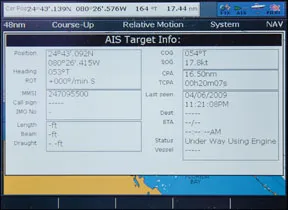
Both the Navico NAIS-300 and the West Marine AIS1000 run on 12-volt DC power and come with GPS sensors.
How We Tested
For testing purposes, we connected each test device to a Raymarine A50D using the displays NMEA-0183 high-speed port and to a Windows-based PC using an RS-232 connector. The connections worked properly on both units. We used a standard VHF antenna and the GPS antennas packaged with each device.
Both were bench tested in the lab and tested for functionality and user-interface on a PS test boat. They were evaluated for their quality of construction, ease of installation, user interface, and available features. Cost and warranty also were considered.
Navico NAIS-300
The Navico NAIS-300 is a full-featured Class-B transceiver housed in a plastic 5.1-inch by 8.2-inch by 2.5-inch “black box” that weighs just over 21 ounces. It can be mounted on a flat surface either vertically or horizontally. The waterproof housing is rated for immersion up to 3 feet for 30 minutes.
The NMEA2000-compliant NAIS-300 requires a connection to its GPS sensor, a VHF antenna for signal reception and transmission, and a display (MFD, chartplotter, or PC). Electrical connections to the Navico unit are made with the provided block connectors or with a SimNet plug-in connector. We used the block connectors for testing.
The unit communicates with a display via SimNet or NMEA0183-HS connection. SimNet is Navicos proprietary high-speed data bus network compatible with NMEA2000; we did not test this connection. the NAIS-300 also can be ordered with the NMEA2000 drop cable.
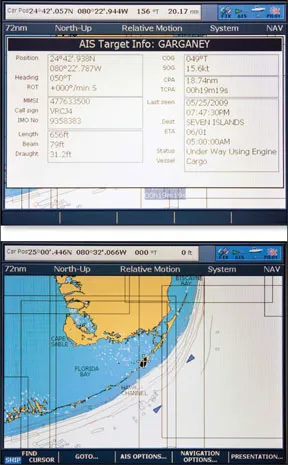
Device information and installation instructions are provided on a CD-ROM that comes with the unit. Testers found installation to be easy: Mount the transponder box and connect it to DC power. Then mount the GPS sensor and connect it to the transponder box. Mount and connect a VHF antenna. And finally, make a data cable connection to your display of choice.
On some displays, the data port will need to be configured by turning on an AIS data layer prior to use; this was the case with the Raymarine A50D. A status icon displayed onscreen lets you know the AIS unit is connected and working properly.
Navico claims the NAIS-300 can receive information and display the position for up to 250 targets. The Navico transceiver allows for a silent mode, which turns off transmissions, rendering the unit a receive-only device. This requires installing a momentary on-switch on the transceiver.
Priced at $1,034, the Navico is quite a bit more pricey than the West Marine, but it comes with a two-year warranty compared to the AIS1000s one-year warranty. However, we would prefer longer warranties for both, given their costs.
Bottom line: The Navico NAIS-300, priced at $1,034, performed well and is rugged and lightweight. It gets our recommendation for those with SimNet electronics andthose who plan to mount it in an area likely to see spray or rain.
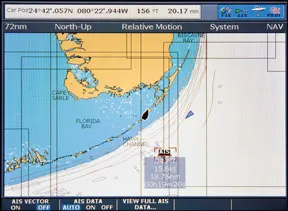
West Marine AIS1000
A full-featured Class B AIS transceiver, the West Marine AIS1000 is housed in a brawny die-cast aluminum casing, measuring 7.6 inches by 5.4 inches by 3.3 inches and weighing just less than 51 ounces. It can be mounted vertically or horizontally.
Unlike the Navico unit, the AIS1000 is not waterproof. The case has seals and bushings surrounding outbound wiring and a gasket sealing the case, which offer some protection against water intrusion, but we recommend mounting it away from possible splashes and sprays.
The AIS1000 ships with the transponder black box, a GPS antenna, a power and data cable, a BNC-to-VHF adapter cable, and a users manual. The manual is thin and contained limited information, in our opinion.
To make the electrical connections for the AIS1000, users must remove eight screws and lift the case top. The transponder must be connected to a power supply, its GPS sensor, a VHF antenna, and a display (compatible chartplotter, MFD, or PC) via an NMEA0183-HS or RS232 port.
To meet the FCCs requirement for dealer-input ships data, West Marine has AIS1000 buyers fill out a form online with required contact, MMSI, and vessel information. The data is entered before the unit is shipped.
Testers found the AIS1000s installation to be fairly straightforward: Mount the black box, connect the power, and hook up the GPS sensor and VHF antenna. A data cable connection to the display also is made. A status icon lets you know its working.
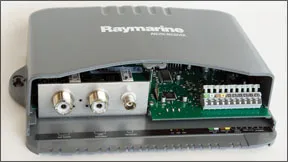
The West Marine transceiver also allows for a silent mode. A pushbutton above the four LED status lights lets users select the receive-only setting and a blue LED indicates that the unit is not transmitting.
Bottom line: The hefty AIS1000 performed well but wed like to see a longer warranty. For $300 less than the Navico, it is our Budget Buy.
Conclusion
As weve said before, AIS technology is an added safety net for collision avoidance, but it is no substitute for proper watchkeeping or radar. As with most electronics, the system is not without its flaws. Some professional mariners have noted that position and bearing data reports from AIS systems can be incorrect due to the use of GPS offset data and the selection of the wrong chart datum. There also have been reports of ships required to carry AIS (including government vessels) turning them off when the captain feels their broadcasts would jeopardize the ships security. So, keep in mind that what the AIS device “sees” may not be the whole picture. AIS reports should be validated with an onboard radar or security calls via the VHF, and skippers should be aware that many recreational boats, fishing boats, and some coastal shore stations are not fitted with AIS transceivers or receivers.
While its not a must-have for every sailor, AIS Class B serves a niche for cruisers, bluewater voyagers, those who often sail in high-traffic areas, and those looking for added peace of mind.
The Navico NAIS-300 came out slightly ahead in this head-to-head challenge, and the West Marine AIS1000 nailed the Budget Buy.





































